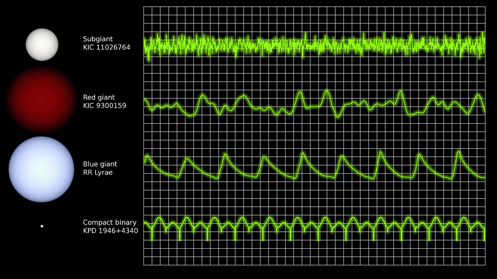Listening to the galaxy
Distant star's sound waves reveal cycle similar to the Sun's
Nov 4, 2010 - by Staff
Nov 4, 2010 - by Staff
2 November 2010 • In a bid to unlock longstanding mysteries of the Sun, including the impacts on Earth of its 11-year cycle, a team of scientists from NCAR, France, and Spain has successfully probed a distant star. By monitoring the star’s sound waves, the team has observed a magnetic cycle analogous to the Sun’s solar cycle. The study was published as a “Brevia” in Science in August.
The scientists studied a star known as HD49933, which is located 100 light years from Earth in the constellation Monoceros (the Unicorn), just east of Orion. The team examined the star’s acoustic fluctuations using a technique called stellar seismology. They detected the signatures of starspots, areas of intense magnetic activity on the surface that are similar to sunspots. While scientists have previously observed these magnetic cycles in other stars, this was the first time they have discovered such a cycle using stellar seismology.

Savita Mathur.
“We’ve discovered a magnetic activity cycle in this star, similar to what we see with the Sun,” says coauthor and NCAR scientist Savita Mathur. “This technique of listening to the stars will allow us to examine potentially hundreds of stars.”
“Essentially, the star is ringing like a bell,” says NCAR’s Travis Metcalfe, a coauthor of the study. “As it moves through its starspot cycle, the tone and volume of the ringing changes in a very specific pattern, moving to higher tones with lower volume at the peak of its magnetic cycle.”
The team hopes to assess the potential for other stars in our galaxy to host planets, including some perhaps capable of sustaining life.
“Understanding the activity of stars harboring planets is necessary because magnetic conditions on the star’s surface could influence the habitable zone, where life could develop,” says the study’s lead author, Rafael Garcia, from France’s Center for Nuclear Studies of Saclay (CEA-Saclay).
Studying many stars with stellar seismology could help scientists better understand how magnetic activity cycles can differ from star to star, as well as the processes behind such cycles. The work could especially shed light on the magnetic processes that go on within the Sun, furthering our understanding of its influence on Earth’s climate. It may also lead to better predictions of the solar cycle and resulting geomagnetic storms that can cause major disruption to power grids and communications networks.
In addition to NCAR and CEA, the team’s scientists are from Paris/Meudon Observatory, the University of Toulouse, and Spain’s Institute of Astrophysics of the Canaries. The research was funded by NSF, CEA, the French Stellar Physics National Research Plan, and the Spanish National Research Plan.
Classifying stars
The scientists examined 187 days’ worth of data captured by the international Convection Rotation and Planetary Transits (CoRoT) space mission.
Launched on 27 December 2006, CoRoT was developed and is operated by the French National Center for Space Studies (CNES) with contributions from Austria, Belgium, Brazil, Germany, Spain, and the European Space Agency. CoRoT is equipped with a 27-centimeter (11-inch) diameter telescope and a 4-CCD (charge-coupled device) camera sensitive to tiny variations in the light intensity from stars.
The study authors found that HD49933 is much bigger and hotter than the Sun, and its magnetic cycle is much shorter. Whereas past surveys of stars have found cycles similar to the 11-year cycle of the Sun, this star’s is less than a year long. This short cycle is important to scientists because it may enable them to observe an entire cycle more quickly, thereby gleaning more information about magnetic patterns than if they only observed part of a longer cycle.
The scientists plan to expand their observations by using other stars observed by CoRoT as well as data from NASA’s Kepler mission, launched in March 2009 (see sidebar). Kepler is seeking Earth-sized planets to survey. The mission will provide continuous data over three to five years from hundreds of stars that could be hosting planets.
“If it turns out that a short magnetic cycle is common in stars, then we will potentially observe a large number of full cycles during Kepler’s mission,” says Metcalfe. “The more stars and complete magnetic cycles we have to observe, the more we can place the Sun into context and explore the impacts of magnetic activity on possible planets hosted by these stars.”
Team members have spent the past six months exploring the structure and dynamics of HD49933 and classifying its size. They will next verify their observations using ground-based telescopes to confirm the magnetic activity of the star. When HD49933 reemerges from behind the Sun in September, they hope to measure the full length of the cycle. The CoRoT mission was designed to collect up to 150 days of continuous data at a time, which was not enough to determine the exact length of the star’s cycle.
—Rachael Drummond
Exploring distant stars has taken on a new life thanks to a wealth of data from NASA’s Kepler space telescope. In four papers published this autumn, scientists have characterized hundreds of stars targeted by Kepler, using the natural pulse of their light waves.
These variations in brightness can be translated into vibrations, or oscillations within the stars, using a technique called stellar seismology. The oscillations can be used by scientists to analyze the internal structures of the stars, in much the same way that seismologists use earthquakes to probe Earth’s interior.
“We’re essentially taking the vital signs of these stars, measuring size, structure, and age, using methods that will also be useful for planet-hosting stars,” says astronomer Joergen Christensen-Dalsgaard (Danish AsteroSeismology Centre), an NCAR affiliate scientist who leads the stellar seismology team.
NASA’s Kepler satellite, launched in March 2009, is designed to discover Earth-like planets orbiting other stars. In the process it is capturing large quantities of data on the target stars. The satellite is using a huge digital camera to continuously monitor the brightness of more than 150,000 stars in its field of view as it orbits the Sun.
Kepler searches for distant worlds by looking for transits, when a planet passes in front of a star, briefly causing it to dim. The amount of dimming reveals the size of the planet compared to the size of the star. Stellar seismology allows scientists to measure the size of the star precisely, yielding the absolute size of any planet. The technique also provides the age of the star, so that the many planets discovered by Kepler can lead to insights into how planetary systems change over time.

This graphic shows five days of light variations observed by the Kepler satellite for four different types of stars: “solar-like” oscillations in a subgiant (top) and a red giant (top middle), pulsations in a blue giant (bottom middle), and eclipses and relativistic beaming in a compact binary star (bottom). The relative sizes of the stars are shown to scale on the left, with the top star about twice the diameter of the Sun. The light variations have been scaled up 100 times for the red giant and compact binary and 1,000 times for the subgiant. (Image courtesy Travis Metcalfe and Tim Bedding.)